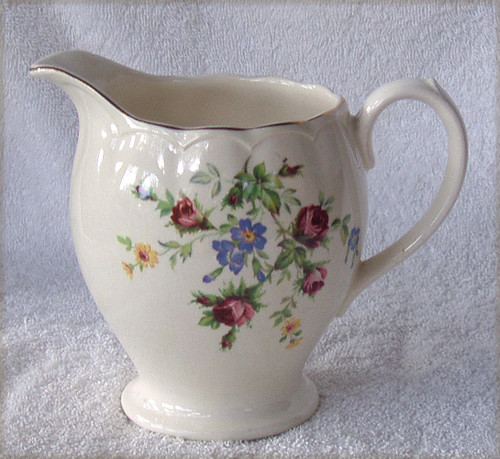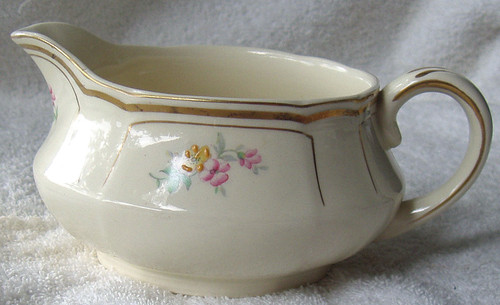British Anchor Pottery Company began operations in 1884, based in Staffordshire and continued until 1970.
Use of the name Regency began in 1952.
A lot of changes occurred around the World War II period, the works actually closed until 1945. Also the well known anchor graphic ceased to be present on the backstamps after the works reopened, being replaced in the early 1950's by a crown graphic. The backstamp on this creamer jug has neither the anchor nor the crown.
I believe the B printed with the backstamp relates to the Wartime Concentration Scheme, many works were closed down to free up workers for the War effort and maximum prices were also set by the Government during these times.
BRITISH ANCHOR - Creamer Jug
Circa 1952+
Opaque China, meaning that when held to the light, you cannot see through the china
Creamer Jug ONLY
Pattern: unknown
Base colour is cream
Hand painted
Artwork design is the very traditional "summer flowers" Red, Blue & a Yellow buds with foliage, one artwork being much larger than the other (there are two areas of artwork)
Textured base china up near the rim of the jug (similar to scroll work) and finished with a single line of Gold gilding around the rim/spout and also on the back (only) of the handle
Hand painted Gold gilding
DIMENSION DETAILS:
CREAMER JUG (Quite large, this stands 110mm (4") high and is 80mm (3") diameter - it will hold a LOT of cream or milk, approximately 500mL)
80mm diameter (widest section of the jug)
115mm high (including the broad, upturned spout)
BACKSTAMP
(Impressed into the base)
L2
(Printed in Olive Green)
Regency (flowing script text)
BRITISH ANCHOR
ENGLAND
B
Both the artist and gilder's marks are visible on the base
CONDITION:
Considering this creamer jug is ALMOST 100 years old, I would describe the condition as VERY GOOD.
Here is a blow by blow account of the condition
CLEAN
NO cracks
NO chips
NO fleabites
NO discolouration to the base or the artwork
NO wear or damage to the artwork
Gold gilding is in very good condition around the entire top of the rim, including the spout and on the back of the handle - no gilding to the sides of the handle.
NOTHING HAND-CRAFTED AND OF SUCH AGE IS PERFECT, HERE IS THE FLAW
Crazing can be viewed fairly easily (although it is less affected than the matching sugar bowl HERE), particularly when held to sunlight. This is a "fact of life" for old chinaware, the glaze shrinks and expands due to heat and cold and produces tiny cracks in the high lustre glaze.
NO ingress of mould or dirt into the craze lines though (now that would NOT look good!)
A very nice example of hand decorated Regency from just after WWII
















